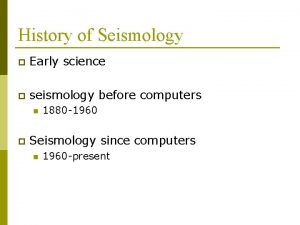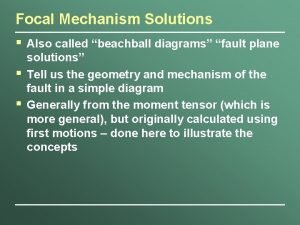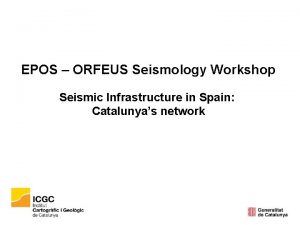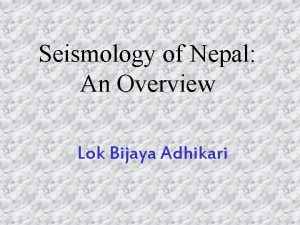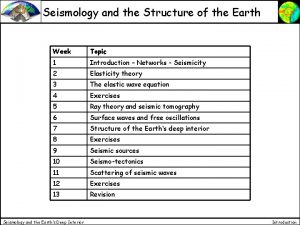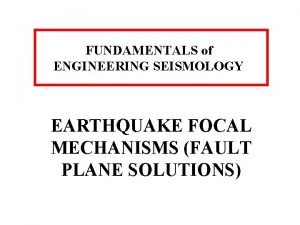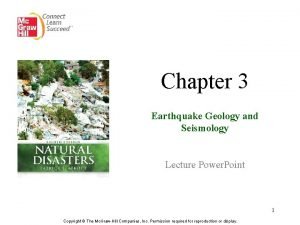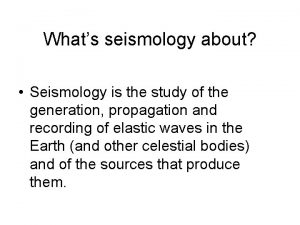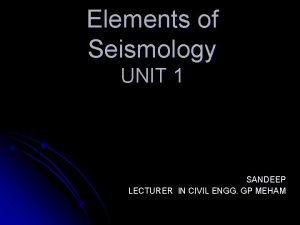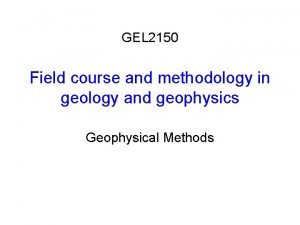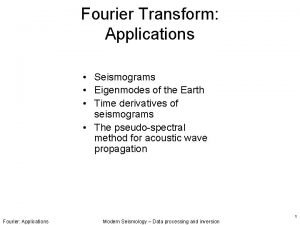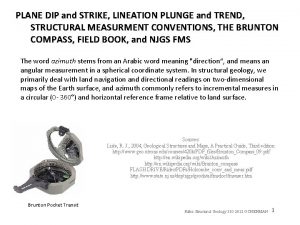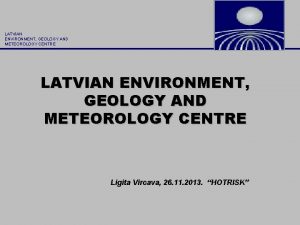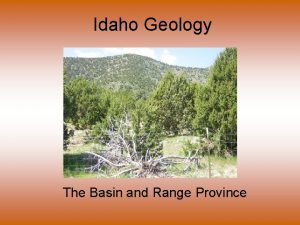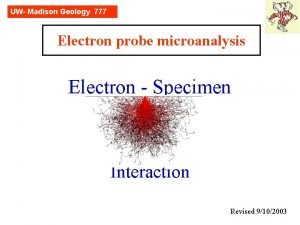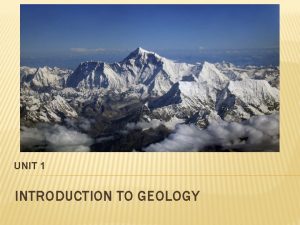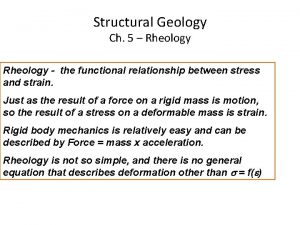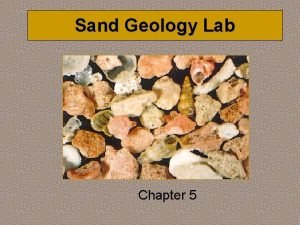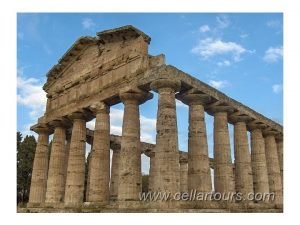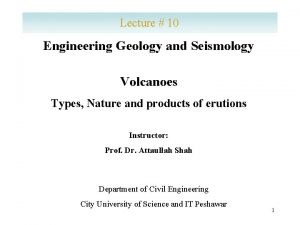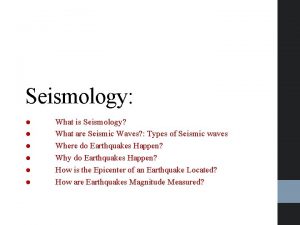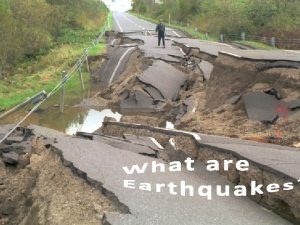Lecture 8 Engineering Geology and Seismology Geology of
































- Slides: 32

Lecture # 8 Engineering Geology and Seismology Geology of Aquifers, Wells, Springs and Ground Water Conditions Instructor: Prof. Dr. Attaullah Shah Department of Civil Engineering City University of Science and IT Peshawar 1

Subsurface (ground) water • Behavior of water in rocks and soils – Porosity, hydraulic conductivity and permeability – Porosity: The property of rocks/soils by which it can hold water. It is expressed in terms of total voids in given volume, which is often identified by void ratio: The ratio of volume of voids to the volume of solids • In general, crystalline igneous and metamorphic rocks have low porosities unless secondary voids such as joints are produced by fracturing – The relative ease of flow by the hydraulic conductivity (K) (referred to as the coefficient of permeability, described empirically by Darcy’s Law. – The properties of the rock alone that affect ease of flow are defined by its intrinsic permeability (k), (usually shortened to permeability)

• Rocks to have permeability and hydraulic conductivity to retain water, but the relationship between porosity and permeability depends mainly on the size of the voids rather than on their frequency

Natural circulation of subsurface water • Precipitation and its dispersal • juvenile water: product of recent volcanic activity and have separated from magma. Often heavily contaminated with dissolved minerals and gases. • Connate water, sealed in porous sediment by surrounding impermeable rocks. If the sediments are marine, the connate water would be saline Juvenile and connate waters form only a minor part of the water present in the uppermost kilometre of the solid Earth.

Global Water Supply Distribution • 3% of earth’s water is fresh - 97% oceans • 1% of fresh water in lakes, streams, rivers • 29% of the world’s fresh water exists in aquifers and 70% in glaciers

Water Supply and Circulation

• Precipitation is dispersed in three ways: (a) by evaporation and by transpiration from plants, (b) by direct runoff in streams and rivers, and (c) by infiltration into the ground. • The factors affecting evaporation are the intensity of the rainfall, the ground temperature, the humidity and the wind strength. It is difficult to measure it directly with accuracy • Surface water runoff can be measured by gauging streams and rivers. Data are collected by the Water Authorities and by some other bodies. The results from selected stations are published annually • The amount of runoff from a given area is related directly to its steepness of slope, and indirectly to the vegetation on it. • The amount of runoff relative to infiltration after a fall of rain depends also, and significantly, on the amount and concentration of the precipitation. •

A globule of water precipitated as rain is dispersed by evaporation, by direct runoff and by infiltration into the ground. The division between runoff and infiltration is determined by the relative resistance to flow along either path.

Basin Hydrologic Cycle – GW/SW Interaction

Ground Water • Ground Water lies beneath the ground surface, filling pores in sediments and sedimentary rocks and fractures in other rock types • Represents 0. 6% of the hydrosphere (35 x the water in all lakes and rivers combined) – Resupplied by slow infiltration precipitation – Generally cleaner than surface water – Accessed by wells of

Porosity and Permeability • Porosity - the percentage of rock or sediment that consists of voids or openings – Measurement of a rock’s ability to hold water – Loose sand has ~30 -50% porosity – Compacted sandstone may have only 10 -20% porosity • Permeability - the capacity of a rock to transmit fluid through pores and fractures – Interconnectedness of pore spaces – Most sandstones and conglomerates are porous and permeable – Granites, schists, unfractured limestones are impermeable

The Water Table • Subsurface zone in which all rock openings are filled with water is the phreatic, or saturated zone • Top of the saturated zone is the water table – Water level at surface of most lakes and rivers corresponds to local water table • Above the water table is an unsaturated region called the vadose zone • A perched water table is above and separated from main water table by an unsaturated zone – Commonly produced by thin lenses of impermeable rock (e. g. , shales or clays) within permeable ones

Ground Water Movement • Movement of ground water through pores and fractures is relatively slow (cms to meters/day) compared to flow of water in surface streams – Flow velocities in cavernous limestones can be much higher (kms/day) • Flow velocity depends upon: – Slope of the water table – Permeability of the rock or sediment

Aquifers and Aquitards • Aquifer - body of saturated rock or sediment through which water can move easily – – – Sandstone Conglomerate Well-jointed limestone Sand gravel Highly fractured volcanic rock • Aquitard - rock/sediment that retards ground water flow due to low porosity and/or permeability – Shale, clay, unfractured crystalline rocks

Aquifers- Sierra Nevada Mtns and foothills • Aquifer - Forms in fractured igneous rock (granitic) - Porosity and permeability are low - Wells are difficult to locate, yield is low - Often limits development

Example Layered Aquifer System Bedient et al. , 1999.

Unconfined vs. Confined Aquifers • Unconfined Aquifer – Has a water table, and is only partly filled with water – Rapidly recharged by precipitation infiltrating down to the saturated zone • Confined Aquifer – Completely filled with water under pressure (hydrostatic head) – Separated from surface by impermeable confining layer/aquitard – Very slowly recharged

Wells • Well - a deep hole dug or drilled into the ground to obtain water from an aquifer – For wells in unconfined aquifers, water level before pumping is the water table – Water table can be lowered by pumping, a process known as drawdown – Water may rise to a level above the top of a confined aquifer, producing an artesian well

Springs • Spring - a place where water flows naturally from rock or sediment onto the ground surface

Ground Water Contamination Infiltrating water may bring contaminants down to the water table, including (but not limited to): – – – Pharmaceuticals Pesticides/herbicides Fertilizers Feed lots Mercury and gold mining Landfill pollutants Heavy metals Bacteria, viruses and parasites from sewage Industrial chemicals (PCBs, TCE) Acid mine drainage Radioactive waste Oil and gasoline

Ground Water Contamination • Contaminated ground water can be extremely difficult and expensive to clean up

Assignment: due within a week • Pick your favorite groundwater contaminant – Write a 1 page (maximum) paper that describes the following: 1) Name of the contaminant, chemical formula 2) How it affects people- when/where is it a problem to the human body, what are the harmful effects? 3) Where it is found, how is it transported, how does it get into the groundwater system? 4) What can be done to solve the problem? Due date: beginning of class, next week

Balancing Withdrawal and Recharge • If ground water is withdrawn more rapidly than it is recharged, the water table will drop – Dropping water table can lead to ground subsidence • surface of the ground drops as buoyancy from ground water is removed, allowing rock or sediment to compact and sink – Subsidence can crack foundations, roads and pipelines – Areas of extremely high ground water pumping (such as for crop irrigation in dry regions) have subsided 7 -9 meters

Recharge Natural • Precipitation • melting snow • Infiltration by streams and lakes Artificial • Recharge wells • Water spread over land in pits, furrows, ditches • Small dams in stream channels to detain and deflect water

Caves, Sinkholes, and Karst • Caves - naturally-formed underground chambers – Acidic ground water dissolves limestone along joints and bedding planes • Caves near the surface may collapse and produce sinkholes • Rolling hills, disappearing streams, and sinkholes are common in areas with karst topography

Hot Water Underground • Hot springs - springs in which the water is warmer than human body temperature – Ground water heated by nearby magma bodies or circulation to unusually deep (and warm) levels within the crust – Hot water is less dense than cool water and thus rises back to the surface on its own • Geysers - hot springs that periodically erupt hot water and steam – Minerals often precipitate around geysers as hot water cools rapidly in the air

Geothermal Energy • Geothermal energy is produced using natural steam or superheated water – No CO 2 or acid rain are produced (clean energy source) – Some toxic gases given off (e. g. , sulfur compounds) – Can be used directly to heat buildings – Superheated water can be very corrosive to pipes and equipment

Streams and Groundwater • Gaining streams - receive water from the saturated zone – Gaining stream surface is local water table • Losing streams - lose water to the saturated zone – Stream beds lie above the water table – Maximum infiltration occurs through streambed, producing permanent “mound” in the water table beneath dry channel

PAKISTAN’S GROUNDWATER RESERVOIR AND ITS SUSTAINABILITY Muhammad Amin Member Water, WAPDA, 705 -WAPDA-House Lahore, Pakistan http: //www. watertech. cn/english/amin. pdf

Groundwater Potentials of Pakistan • Groundwater Potential in Punjab – Four hydrogeological zones, namely Potohar plateau & salt range, Piedmont areas, Alluvial plains and Cholistan desert – The total available groundwater resource of the Punjab Province was estimated 42. 75 MAF. • Groundwater Potential in Sindh – The groundwater lies in the three hydrogeological zones namely Eastern (Thar) desert, Western mountain and Indus valleys – The total available resource of the Sindh Province was assessed to be 18 MAF. • Groundwater Potential in KP – Four broad geological units namely, metamorphic and igneous rocks of the northern mountains, Mesozoic rocks of the southeastern part, Tertiary rocks of the southeastern part and upper Tertiary. – The total available resource of the KP Province was assessed to be 3. 11 MAF • Groundwater Potential in Balochistan – The groundwater resources in six basins of the province namely Hamune, Lora, Kachhi Plain, Nari, Pishin and Zhob have been assessed as 1. 21 MAF and Total of 2. 31 MAF

Conclusions 1. Groundwater has become a major source of water supply in Pakistan 2. Excessive use of groundwater is causing secondary salinisation 3. The situation has worsened in a number of sub-basins in Balochistan Province due to groundwater mining 4. Continuous over-draft has resulted in excessive groundwater abstraction, so that 5% area of Punjab Province and 15% of Balochistan Province contain groundwater out of reach of poor farmers 5. Up-coning of deep saline water has started in some parts of Pakistan 6. There is a need to realistically estimate and manage the demand for water 7. The flat-rate energy charge has encouraged farmers to exploit more and more groundwater, which has resulted in an unsustainable

Recommendations 1. A groundwater regulatory framework should be introduced and implemented for the sustainability of groundwater use 2. There is need to manage the demand of water 3. Low water delta crops should be preferred to high delta crops 4. Efficient irrigation methods should be used to irrigate crops 5. Recharge of groundwater should be increased by increasing canal diversions, rainwater harvesting and check dams 6. Saline water can be used for saline agro-forestry or for alternative agricultural crops 7. Energy charges should be proportional to the use of energy for tubewells 8. Research on groundwater recharge is urgently required.
 Geology lecture series
Geology lecture series Seismology timeline
Seismology timeline Beach ball diagram
Beach ball diagram Orfeus seismology
Orfeus seismology Seismology nepal
Seismology nepal Seismology
Seismology Beach ball geology
Beach ball geology Two types of body waves
Two types of body waves Whats seismology
Whats seismology Elements of seismology
Elements of seismology Seismology
Seismology Seismology
Seismology Seismology
Seismology 01:640:244 lecture notes - lecture 15: plat, idah, farad
01:640:244 lecture notes - lecture 15: plat, idah, farad Financial engineering notes
Financial engineering notes Software engineering lecture notes
Software engineering lecture notes Foundation engineering lecture notes
Foundation engineering lecture notes Descriptive ethics
Descriptive ethics Forward engineering in software engineering
Forward engineering in software engineering Convert trend and plunge to dip and dip direction
Convert trend and plunge to dip and dip direction Latvian environment, geology and meteorology centre
Latvian environment, geology and meteorology centre Basin and range geology
Basin and range geology What is system in software engineering
What is system in software engineering Principles of complex systems for systems engineering
Principles of complex systems for systems engineering Elegant systems
Elegant systems Forward and reverse engineering
Forward and reverse engineering Geology is the study of
Geology is the study of Uw
Uw Geology what is
Geology what is Geology
Geology Stratigraphy
Stratigraphy Grain size card
Grain size card What is differential stress
What is differential stress

